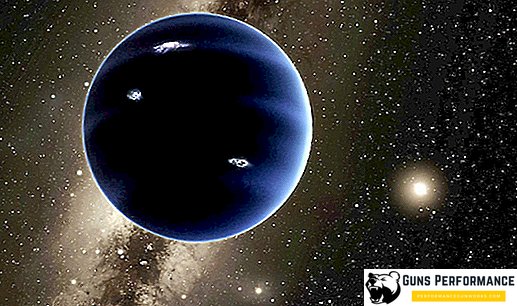Today astrophysics is considered one of the most controversial and dynamically developing sciences. If classical and academic truths dominate in physics and mathematics, they have become assertions and axioms, in astronomy, scientists constantly have to deal with something new, proving the opposite for well-established assertions. The current technical advances allow the scientific community to conduct a more detailed study and exploration of space, therefore, more and more often in modern science situations arise that are similar to the one around Pluto.

Since 1930, since its discovery, for some time Pluto was considered a full-fledged planet, having a ninth serial number. However, the celestial body was not in such a status for long - only 76 years. In 2006, Pluto was excluded from the list of planets in the Solar System, moving into the category of dwarf planets. This step on the part of the scientific community has broken the classical view of the solar system, becoming a precedent in modern science. What was the reason for modern science to take such a radical decision and what can we face tomorrow, while continuing to study the near space?
The main characteristics of the new dwarf planet
To come to the decision to transfer the ninth planet into the category of dwarf planets, humanity took a little time. The period of 76 years, even by earthly standards, is considered short enough so that significant changes can occur in the astrophysical laboratory. However, the rapid development of science and technology over the past years has cast doubt on the seemingly indisputable fact whether Pluto is a planet.
Even 15-20 years ago in all school textbooks on astronomy, in all planetariums, Pluto was spoken of as a full planet of the Solar System. Today this celestial body is lowered in rank and is considered a dwarf planet. What is the difference between these two categories? What does Pluto lack to be considered a full-fledged planet?

The size of the ex-planet is really very small. The size of Pluto is 18% of the Earth, 2360 km against 12742 km. However, even with such small sizes, Pluto had the status of a planet. This situation looked somewhat unusual given the fact that there are quite a few natural satellites in the solar system that have much larger dimensions. Why are only the giant satellites of Jupiter and Saturn - Ganymede and Titan - their size exceeds even Mercury. In terms of its physical parameters, Pluto is inferior even to our Moon, whose diameter is 3,474 km. It turns out that the size of a celestial body in astrophysics is not always the main criterion for determining its status.
Pluto's small size did not prevent astronomers from theoretically recognizing its presence for a long time. Long before its discovery, this celestial object bore a modest name - Planet X. In 1930, the American astronomer Clyde Tombo visually discovered that the star he was watching in the night sky was moving in its own planetary orbit. Then scientists considered that the ninth planet of the Solar System, whose orbit is the boundary of our Solar System, is before them. The scientific community was not confused by the size of the newly discovered celestial body, or its orbital parameters. To top it all off, the new planet was given a solid name - Pluto, given in honor of the ancient Greek god, the lord of the underworld. The distance from the Sun to the ninth planet was 5.9 billion km. These parameters were then used for a long time to determine the scale of our solar system.

The one who discovered the planet did not have the technical ability to look deeper into space and put everything in its place. At that time, astrophysicists had limited knowledge and information about the border areas of our solar system. They did not know where the near space ends and the infinite outer space begins.
Why is Pluto not a planet?
Despite the fact that the former ninth planet was tiny in size, it was considered the last and only major celestial body located beyond the orbit of Neptune. The appearance of more powerful optical telescopes in the second half of the 20th century completely changed the concept of outer space surrounding our star system. In addition to the fact that scientists managed to find their own natural satellites in baby Pluto, the status of the ninth planet was shaken.

The main reason for the changed attitude of scientists to a small planet was the detection at a distance of 55 AU. from the Sun large clusters of celestial bodies of various sizes. This area extended immediately beyond the orbit of Neptune and was called the Kuiper belt. Subsequently, in this region of space, numerous objects with a diameter greater than 100 km were found and in their composition similar to Pluto. It turned out that a small planet is just one of many celestial bodies rotating in such a tight circle. This was the main argument in favor of the fact that Pluto is not the last large celestial body found beyond the orbit of Neptune. The first sign was the discovery of a small planet Makemake in 2005 in the Kuiper belt. Behind her in the same year, astrophysicists discovered three more large celestial bodies in the Kuiper belt, which received the status of trans-Neptune objects — Haumea and Sedna. In size, they are slightly inferior to Pluto.
2005 was a turning point for astrophysicists. The discovery of numerous objects outside the orbit of Neptune has given scientists a reason to believe that Pluto is not the only large celestial body. Perhaps in this region of the solar system there are objects similar or larger than the ninth planet. Received accurate information about Eris, put an end to disputes about the fate of Pluto. It turned out that Eris is not only larger than the planetary disk of Pluto (2600 km against 2360 km), but also has a full quarter more mass.

The availability of such information led to the fact that the scientific community had to urgently look for a way out of this situation. At international conferences among scientists and astrologers, real battles took place on this occasion. After the first speeches of scientists and astrologers, it became clear that Pluto cannot be called a planet. They accumulated a lot of material in favor of the fact that in the Kuiper belt, along with Pluto, there are other objects with similar astrophysical parameters and characteristics. Supporters of the revision of the concept of the classical structure of the solar system put forward the assumption that all trans-Neptunian objects should be made up into a separate class of celestial bodies of the solar system. According to this concept, Pluto became an ordinary trans-Neptune object, completely losing its status as the ninth planet of our star system.

The point in this matter was set by the members of the International Astronomical Union, who met in Prague for the XXVI General Assembly. In accordance with the decision of the General Assembly, Pluto was deprived of the status of the planet. On top of that, a new definition has appeared in astronomy: dwarf planets are celestial bodies that meet certain criteria. They attributed Pluto, Eridu, Makemake and Haumeu and the largest Asteroid - Ceres.
It is believed that Pluto, unlike other large celestial bodies, does not meet one of the four criteria according to which a celestial body can be classified as a planet. For the former ninth planet is characterized by the following features:
- the presence of a sufficiently large mass;
- Pluto is not a satellite, and has four natural satellites;
- the celestial body has its own orbit, in which Pluto makes a revolution around the Sun.
The last fourth criterion, which allows to classify Pluto as a planet, is absent in this case. Neither before nor after the celestial body could it clear the orbital space around itself. This was the main argument in favor of the fact that Pluto is now a dwarf planet, a celestial body with a completely different status.

In support of this concept, a version of the formation of the planet is given, when it becomes the dominant object in a particular orbit, subjecting all other bodies to its own gravitational field. Subsequently, a large celestial body must either swallow smaller objects or push them beyond the limits of its own gravity. Judging by the size and mass of Pluto, nothing like this happened to the ex-planet. A small planet has a mass equal to only 0.07 the mass of all space objects included in the Kuiper belt.
Basic data about Pluto
In the past, when Pluto was a full member of the club of the planets, it was counted among the terrestrial planets. Unlike the gas giants Jupiter, Saturn, Uranus and Neptune, the former planet has a solid surface. It was not until 2018, when the New Horizons space probe flew 12 thousand km from the underground god, to examine the surface of the most distant object of the Solar System from close range. With the help of this automatic probe, a person first saw the surface of a dwarf planet in detail and was able to make a brief description of this celestial body.

A small planet, which is visible in the sky with a barely noticeable asterisk, runs around the Sun for 249 years. At perihelion, Pluto approaches it at a distance of 29-30 AU, while in aphelion a dwarf planet is removed at a distance of 50-55 AU. Despite such great distances, Pluto, unlike its neighbors Neptune and Uranus, is open to the study of the icy world. The kid spins around its own axis at a speed of 6 days and 9 hours, although its orbital speed is rather small - only 4.6 km / s. For comparison, the orbital speed of Mercury is 48 km / s.

The area of the planet is 17.7 million square meters. kilometers Almost the entire area of the surface of the planetary disk is available for viewing and represents the realm of eternal ice and cold. It is assumed that Pluto consists of frozen water ice, nitrogen and silicate rocks. In other words, it is a huge ice block, the density of which is 1,860 ± 0,013 g / cm3. The average temperature on the planet is extreme: - 223 degrees Celsius below zero. Weak gravitational field and low density led to the fact that on Pluto the minimum value of the acceleration of gravity is 0.617 m / s2.

Judging by the pictures, there are depressions and mountains on Pluto, the height of which can reach 3-3.5 km. In addition to the solid surface, Pluto also has its own atmosphere. The weak gravitational field does not allow the planet to have an extensive air-gas layer. The thickness of the gas interlayer is only 60 km. These are mainly gases that evaporate from the icy surface of Pluto under the influence of hard ultraviolet radiation.
New discoveries from the life of Pluto
In addition to all the available information about Pluto, recently managed to detect the atmosphere and on Charon - Pluto's satellite. This satellite is slightly smaller than the main planet, and scientists have their own ideas about this.

The latter fact is quite curious. There is a version that Pluto and Charon are a typical double planet. This is the only case in our solar system where the maternal celestial body and its satellite are in many ways similar to each other. Whether this is so - time will show, while humanity continues to collect interesting facts about the Kuiper Belt, where, along with Pluto, there are still many interesting space objects.












